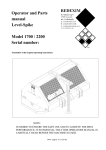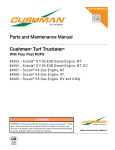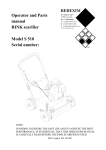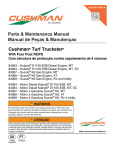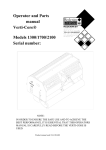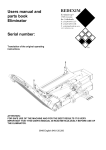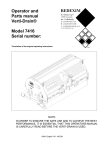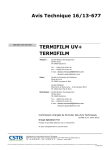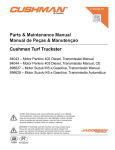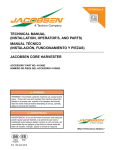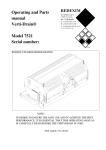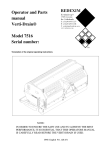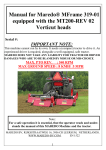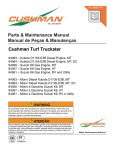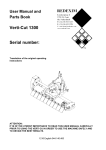Download Multi-Spike 1200 - Charterhouse Turf Machinery
Transcript
Operator and Parts manual Multi-Spike Model 1200 Serial number: Translation of the original operating instructions NOTE: IN ORDER TO ENSURE THE SAFE USE AND TO ACHIEVE THE BEST PERFORMANCE, IT IS ESSENTIAL THAT THIS OPERATORS MANUAL IS CAREFULLY READ BEFORE THE MACHINE IS USED. 0948 English 913.120.400 FOREWORD. Congratulations on the purchase of your Redexim- Charterhouse MULTI-SPIKE. To ensure the safe and lasting operations of this MULTI-SPIKE you (and anyone using the machine) should read and understand this user’s manual. A complete knowledge of the contents of the manual is necessary in order to ensure the safe use of this machine. The MULTI-SPIKE is not an independently operating machine. It is the responsibility of the user to use the correct tractor. The user will also need to check the tractor / MULTI-SPIKE combination on safety aspects, noise level, user instructions and risk assessment. The MULTI-SPIKE is intended exclusively for grass fields or areas on which grass can grow. On the following page, we will begin with the safety instructions. Every user must be familiar with these instructions and must follow them carefully. Attached and below you will find a registration card, which should be returned to us so that we are able to process any future claims. In this manual, many instructions are given which are stated in a number sequence. The user must follow the instructions according to this sequence. If the * appears this refers to safety instructions. If the @ is used, this refers to a tip and/ or note. All information and technical specifications provided at the moment that this document is published are the most recent ones. Design specifications may be changed without prior notice. This document is a translation of the original operating instructions. Upon request, the original operating instructions are available in Dutch. GUARANTEE CONDITIONS. THIS MULTI-SPIKE PRODUCT IS DELIVERED TO THE CUSTOMER ACCOMMPANIED BY A GUARANTEE AGAINST DEFECTS IN THE MATERIALS USED. THIS GUARANTEE APPLIES FOR A PERIOD OF 12 MONTHS AS OF THE DATE OF PURCHASE. Redexim- Charterhouse GUARANTEES ARE SUBJECTED TO THE "GENERAL CONDITIONS FOR SUPPLY OF PLANT AND MACHINERY FOR EXPORT, NUMBER 188", WHICH ARE PUBLISHED UNDER THE AUSPICES OF THE UNITED NATIONS ECONOMIC COMMISSION FOR EUROPE. REGISTRATION CARD. For your own record, copy the information from the registration card to the table hereunder. Mail the attached card back to us. Serial number of machine Name of your distributor Date of purchase Any remarks 2 SAFETY INSTRUCTIONS. 1. Always use the MULTI-SPIKE with the correct tractor as described in the technical information 2. The user is responsible for a safe Tractor/MULTI-SPIKE combination. The combination must be tested for noise, safety, risk and easy usage. It is also necessary to draw up user instructions. 3. The MULTI-SPIKE is suited exclusively to grass fields. 4. Every MULTI-SPIKE user must be fully informed of the information contained in the user manual. 5. Inspect the ground where the MULTI-SPIKE is to be applied. Remove loose obstacles, avoid uneven ground. 6. Never step off the tractor if the engine is still running. 7. Ensure that other people are standing at least 4 mtr. (14' ) away from the MULTI-SPIKE 8. Use appropriate clothing. Wear strong shoes with a steel inforced toe cap, long trousers, tie up long hair. Do not have any loose pieces of clothing. 9. Never try to force the MULTI-SPIKE, a situation which is visible in unstable behavior of the MULTI-SPIKE. 10. Check the MULTI-SPIKE once a week to ensure there are no loose screws or nuts and bolts. 11. The MULTI-SPIKE may never be used without protection covers and safety stickers. 12. NEVER crawl underneath the MULTI-SPIKE. If you need to work underneath, turn the MULTI-SPIKE on its front. 13. Always switch off the engine, before starting any maintenance, adjustment or repair. Also block the MULTI-SPIKE against sinking and block it against forward/backward movement or sliding. 14. Use only the original MULTI-SPIKE spare parts/ tines in order to ensure the safe operation of the machine. 15. Never use the MULTI-SPIKE in the dark, in heavy rain, on frozen ground, stormy conditions or on slopes greater than 20 degrees. 16. Maintain a log book of repairs. 17. If any modifications are carried out on the machine the CE certification mark will be no longer valid. The User/Dealer himself must then have the machine re-certified. 3 CONTENTS. Par. Description Page Foreword 2 Guarantee conditions 2 Registration card 2 Safety instruction 3 1.0 Technical specification 5 2.0 First setup 7 3.0 General controls 8 4.0 Working depth adjustment 9 5.0 Groundspeed 9 6.0 General usage of the Multi-Spike 10 7.0 Transport of the Multi-Spike 10 8.0 Uncoupling of the Multi-Spike 10 9.0 Problem analysis 11 10.0 Maintenance 11 11.0 EU-Declaration 11 12.0 Options 12 12.1 Additional Truckster knife kit 13 12.2 Fine slit knife kit 13 12.3 Deep slit knife kits 14 12.4 Hollow tine kit 14 12.5 Wheel kit 15 12.6 Weight transfer kit 17 4 1.0TECHNICAL SPECIFICATIONS. Model 1200 Working width 1350 mm (56”) Working depth Up to 250 mm (10”) Weight 400 Kg (880 lbs) Hole spacing side-to-side 75 mm (3”), with fine slit knives 150 mm ( 6”), with all other knives/ tines Hole spacing in drive direction, at maximum depth center-to center With 3 knives per disk: 440 mm (18”) With 4 knives per disk: 330 mm ( 13”) With 6 knives per disk: 220 mm ( 9”) With 12 knives per disk: 110 mm (4 ½”) Recommended minimum tractor size 18 HP with lift capacity of minimum 500 Kg ( 1100 lbs), or 12HP for towed version Capacity: At 5 km/hour ( 3.1 mph) 6750 m² (60,000 sq ft)/hour At 10km/hour (6.2 mph) 13500m² (120,000sq.ft)/hour At 15km/hour (9.4 mph) 20250m² (180,000sq.ft)/hour Shipping dimensions 1480 x 550 x 1640 mm (59”x 22”x 66”) L x W x H Three point linkage 3- point CAT 1 & 2 Lubrication grease EP 2 Standard items Truckster knife kit ( 4 per disk) Rear roller assembly Manual Support jack 5 6 2.0 FIRST SETUP. The machine is delivered on a pallet. To install the machine behind a tractor, handle as follows (see fig.1, 2, 3, 4, 5 and 6 ) 1. Remove all boxes from the machine, which contain knives, bearings, safety bars, bolts/nuts and a jack. 2. Firmly connect a sling 2 of approximately 2.5 mtr (8 ‘) with D- shackles to the holes 1 at each side of the machines as shown in Fig.1. 3. Lift the machine slowly. Be aware that the machine may be unstable during the tip over, however it will not drop on the ground. 4. Lay the machine horizontal on a flat floor, as shown in Fig.2. 5. Remove the two bolts 5 that hold the main rotor. Check that the main rotor lays on the ground. When both bolts 5 are out, the rotor can be rolled back till it is in position 6. 6. Slowly lift the machine again, see Fig.3., till the rotor can be rolled away. 7. The truckster knives ( standard delivered with machine), can be mounted to the rotor, as shown in Fig.4. In Fig.4. four knives are evenly fitted at a disk. On the next disk, the knives should be mounted with an offset. In Fig.4 this is indicated with a number on the knives. One means the first disk etc. Mount the knives exactly the same way as drawn in Fig.4. For more information on knives and the assembly, see Chapter 12. 8. Lower the machine back on the ground. Remove the Pallet and connect the machine to a tractor. ( Leave the rear roller fixed). 9. Lift the unit with the tractor as much as possible. Shorten the toplink when necessary. Roll the rotor with mounted knives under the machine. Assemble the rotor bearing on the rotor ends and use the bolts/ washers 14 and nuts to firmly mount the rotor to the main frame. When everything fits well, tighten the grub screw of the bearings. 10. The rear roller can be set in the right position. First remove the lock pins 11 at each side. Next remove the bolts 12A and assemble bolt 12 in hole 12B, with the bushes the same way. Tighten the bolts/nuts 12 in hole 12B. Check whether the rear roller guides 15 are free to move. The rear roller scraper 16 is adjustable. Check the current setting. 11. The last items to assemble are the safety bars 17, that are identical. They should be on. Use two bolts/ nuts at each side. 12. Slide the jack 13 upside down on and lock it with the lock pin. • Be very careful during all operations and do not take any unsafe steps. • Be aware of the knives during handling. They are sharp and can seriously hurt you. Stay away with your hands and feet as much as possible. Use protection gloves. • If you prefer, you can exchange or mount the knives, via the top cover gaps. Mount the rotor first in the unit, remove the two front or rear covers and assemble the knives from the top. LOCK the machine. @ If the tractor can’t lift high enough, use the sling again or assemble the knives afterwards, see above. @ The position of the blades at the rotor and the position of the rotor in the main frame is critical for the final job done. So check this carefully with the figures 1 to 6 and Chapter 12. 7 3.0 GENERAL CONTROLS In fig.2. some key details of the machine are shown, as follows: 1. Hook up points or securing points when weights are added. 2. Area for extra weights. NOTE. The maximum load applied may not exceed 300 Kg (660 lbs). 3. Safety decal RB and RC. Keep 4 mtr (14’) distance to the machine/ Turn engine off when maintaining or repairing the machine. 4. Rear roller scraper. 5. Adjustment bolts for rear roller scraper. 6. Depth control holes. 7. Hole for storing the pin, when rear roller floats. 8. Safety bar at each side of machine. Should be on all the time 9. Manual box with manual enclosed and safety decal RA: Read manual before using machine. 10. Serial number plate. 11. Cat. 1 & 2 bottom link pin. 12. Jack for supporting and securing machine during storage and repair. 13. Pin to lock jack to machine. Jack can be reversed when fixed to a tractor. 14. Cat 2 top link pin. 15. Bolts/ nuts/ washers for keeping safety covers in place. Fig.7. 8 4.0 WORKING DEPTH ADJUSTMENT. The working depth can be set by locking the rear roller supports 3 with pin 2 at a certain level. When the machine is at 90 degrees behind the tractor, the depth D is maintained. The lock pin is a coarse setting. The fine tuning can be done with the top link of the tractor. If the rear roller has to float, store the lock pin 2 in hole 4. @ The rear roller locking may ONLY be used when no Weight Transfer System or extra weights are used. Otherwise serious damage may appear. @ The rear roller may be locked for storage as well, however only when the roller rests ON the ground. If that does not happen the machine may tip. @ Use the 90 degrees setting always as the starting point. 90 D 5.0 GROUNDSPEED. The forward speed during work, should be limited till 15 km/hour ( 9.4 mph). Faster is not allowed. The faster we go, the less time a knife has for penetration. So working slower may give a better result in the end. This depends on the soil as well. @ Make only straight passes with a 3-point linkage model. @ The unit can be lowered into the ground and raised without stopping the tractor. * Be aware that the rotor may continue to run when raised during forward motion. Don’t come close the machine, but drop it first in the ground to stop 9 6.0 GENERAL USAGE OF THE MULTI-SPIKE The MULTI-SPIKE can only be used when the circumstances are right. Check the following items: 1. Are there any loose objects on the field. If so, these must be removed first. 2. Are there any slopes. The maximum slope for the MULTI-SPIKE is 20 degrees. Always operate the MULTI-SPIKE from the top to the bottom of a slope. 3. Are there any pipes/wires/cables in the ground. If so, ascertain at what depth and set the working depth at a maximum of 60% of the pipe etc. depth. 4. Are there any hard objects in the ground. If so, operate the MULTI-SPIKE with a very low speed, or adjust working depth. 5. Is there any danger of flying objects such as golf balls, which could distract the attention of the driver ? If so, the MULTI-SPIKE can not be operated at that moment. 6. Is there any danger of subsidence or land/mud slides ? If so, the MULTI-SPIKE cannot be operated on the field at that moment. 7. Is the ground frozen or very wet. Postpone operation till circumstances are better. 7.0 TRANSPORT OF THE MULTI-SPIKE. The user is responsible for the transport of the MULTI-SPIKE behind the tractor along the public streets. Check on the national legislations. Across open ground a maximum speed of 20 km/h (13 mph) applies. In view of the weight of the MULTI-SPIKE, a higher speed could be dangerous for the driver and bystanders. The machine could also suffer damage due to jolt which can occur with higher speeds. * At least 20% of the tractor weight should rest on the front axle when machine is lifted. 8.0 UNCOUPLING OF THE MULTI-SPIKE. The machine can be disconnected from the tractor as follows, 1. Look for a flat area. 2. Lock the rear roller in bottom position, or leave it free floating. 3. Reverse the jack. 4. Gently lower the machine with the knives on the ground. 5. Drop the jack, till the machine is well supported. 6. Remove the top link 7. Remove the bottom link. • The area needs to be level. • Additional weight has to be taken off first.. 10 9.0 PROBLEM ANALYSIS. Slits/ holes are badly shaped Wrong type of knife Use other type Weak soil Reduce working depth Use other type of knife Knives at wrong position Check correct position Try other position 10.0 MAINTENANCE. Pre-Delivery-Inspection Check bolts/ nuts Connect the unit to a tractor Mount the tines/ knives See instructions in this manual See Chapter 2 and 12 Weekly Clean machine After first 20 hours Grease rotor and roller bearings (new or repaired) 2 shots each EP 2 Check bolts/nuts After every 100 hours Grease rotor and roller bearings. 2 shots each EP 2 Check bolts/ nuts 11.0 EU-Declaration. We, Redexim Utrechtseweg 127 3702 AC Zeist Holland, hereby declare fully on our authority that the product: MULTI-SPIKE 1200, WITH SERIAL NUMBER AS INDICATED ON THE MACHINE AND IN THIS MANUAL, to which this declaration relates is according to the stipulation of the 2006/42/EC directive for machines. Zeist, 01/10/09 A.C. Bos Manager Operations & Logistics Redexim Holland 11 12.0 OPTIONS (see fig.8.) Standard the MULTI-SPIKE 1200 is delivered with a set of 36 Truckster knives. Basically, depending on the knife or tine size, we can mount 3,4,6 or 12 knives evenly per disk. With the kit of 36, we can mount 4 per disk, as is shown in Fig.8. It is important to mount the knives in the holes as shown in Fig.8. Use bolt 2 and nut 3. In the figure the preferred rotation direction is given as well. Be aware that the rotor is mounted correctly in the main frame, so the rotation direction works out well. @ In almost all cases the MULTI-SPIKE is towed behind a tractor. However in case the unit is pushed, the rotor should be reversed. @ Under some conditions, the knives may do a better job when reversed. The best way to try is reversing the drive direction and look at the results. If the results are better, reverse the rotor in the main frame. @ The more knives/ tines are assembled, the closer the pattern. However the more weight is needed for penetration either. So if you require depth, use less knives. @ The disks are welded offset to each other, so we can create a spiral ( 4 in Fig.8.), which makes the machine run smoother. Be aware of this when more knives are added. @ Changing or adding knives/ tines can be done in two ways: 1. Remove the whole rotor and change/ add knives, see instructions in Chapter 2. 2. Remove the covers, see # 15 in Fig.7, and work from the top • Be aware of sharp items. Work carefully. Secure the machine all the time with the jack • Never crawl under the machine or rotor • Always secure the rotor from rolling away. 12 12.1 ADDITIONAL TRUCKSTER KNIFE KIT (see Fig.9.). In case you want to use 6 Truckster knives per disk, instead of the 4 we standard deliver, an additional kit # 213.120.006 is available, that contains 18 more truckster knives with bolts and nuts. When 6 truckster knives per disk are used, it is important to mount them the same way as drawn in Fig.9. Three on one side of the disk, three at the other side. They all should be in the same position. Use the holes as given in Fig. 8. 12.2 FINE SLIT KNIFE KIT ( See Fig.10). The fine slit knives fit on the same rotor. Distance bushes are used to offset the knives from the disks, see Fig.10. Each disk can take up to 12 fine slit knives per side. It is important to know that on both outer disks, we can not assemble fine slit knives at the outer side. The fine slit knife kit # 213.120.008 contains: 192 fine slit knives (1), 384 distance bushes (4,5 & 8), 168 long bolts (6), 48 short bolts (9) and 216 nuts (3). They should be assembled as drawn in Fig.10. As described previously, more options are possible. E.g. use 6 double row fine slit knives, or 12 at a single row per disk ( no distance bushes needed). @ If the customer often switches from one type of knife to the other, it is maybe worth buying another standard rotor and exchange rotors instead of knives. @ Check the bolts and nuts regularly. @ Exchange bent knives immediately. 13 12.3 DEEP SLIT KNIFE KITS (See Fig. 11 and 12). Deep slit knives fit to the Multi-Spike 1200 as well. The standard kit # 213.120.010 contains : 36 deep slit knives (2), 72 bolts (3) and 72 nuts (1).`They should be assembled as drawn in Fig.11. If you want to add more knives, an additional deep slit knife kit # 213.120.012 is available, which is half the size of kit # 213.120.010. This means that when added, we can increase the number of knives per disk from 4 to 6, as drawn in Fig. 12. 12.4 HOLLOW TINE KIT ( See Fig.13). A Hollow tine kit # 213.120.014 is available for the standard rotor. The kit contains: 54 x Hollow tine (2), 108 x nut (3) and 108 x bolt (4). Assemble them as is drawn in Fig. 13. Divide them even around the disks. If you want to use 12 per disk, simply order another kit # 213.120.014. @ Don’t use extra weight, the tines may collapse. @ If the holes do not look well, reduce the working depth. @ It is normal that they may fit a bit tight. Use a small (plastic) hammer. 14 12.5 WHEELKIT (See Fig 14.) 250401 A wheel kit is available as an option for easy transport behind ( small) tractors and Truckster type vehicles. The following point are important: - The vehicle needs to have double acting hydraulic outlets - Extra weights can be used on top of the Multi Spike for better penetration ( max 300 Kg [660lbs]). - Check the national legislation for road use. - Off the road ,a maximum speed of 16 Km/h ( 10 mph) is permitted. - Always lower the Spiker on the ground and use the jack before taking the vehicle away. - Curves can be made during work. - The tow bar strips can be set at different heights, to cope with different vehicles. - The tire pressure should range between 1 and 2 bar ( 14- 28 PSI). - The wheels should be released from the ground 25 mm ( 1”) during work. 15 The assembly of the kit goes as follows, see Fig 14. 1. SECURE THE BASE MACHINE AGAINST ANY MOVEMENT TIGHT ON A HARD GROUND. 2. Spread and divide all delivered items nicely on the ground. 3. Assemble the main beam 16 with bolts 18/31, pivot bushes 20 and washers 19 to the main frame of the machine, using the bottom holes. Tighten the bolts/nuts and check whether the beam pivots nicely. 4. Assemble the wheel support plates 5 and 9 to the main beam 16 with bolts 13 and nuts 17. Before tightening, add the U bridge 14 with bolts 12 and nuts 15. Assemble the wheel 7 with main shaft 4 and distance bushes 6 and 8. The lock pin 3 should fit the hole in strip 5. Tighten bolt 10 using a washer and springwasher 11. Align the position of the wheel 7 to the machine and tighten all bolts/ nuts of the support strips 5 and 9. 5. The wheel kit is fully symmetric. So assemble the wheel at the other side the same way. 6. Bolt the draw bar 26 to the main beam 16 with bolts 28, plate 29 and nuts 30. 7. The draw bar plates 23 and 24 can be mounted with bolt 25 and nuts 27. They can be set in two positions and also reversed. NOTE. The two plates are needed in case the vehicle has one single hook up plate. If two, we can use only 23. 8. Jack 21 is NOT included in the kit. Use the one that was standard delivered with the machine. NOTE. The jack can be reversed, when the machine is secured to the vehicle. 9. Assemble the hydraulic cylinder between the draw bar 26 and the top link of the machine. Use the standard top link pin for the machine side. The rod side of the cylinder should face the machine. 10. The hoses 37, the nipples 36 and the quick connectors 35 are equal and should be mounted to one side of the hydraulic hose. Use copper washers between 36 and 35. 11. One hose is connected with a Olive straight connector 38 to the bottom of the hydraulic cylinder. Use a copper washer between 38 and the cylinder house. 12. The other hose is connected to the rod end of the hydraulic cylinder. A flow reducer 41 should be mounted to the cylinder first ( use a copper washer), next a straight two sided olive type connector 40 should be added. The hose will fit 40. 13. Check all bolts and nuts on tightness. 14. Put the machine behind the vehicle. To remove the air, raise and lower the machine 10 times very slowly. 15. The machine is ready to use. * Stay 4 mtr (14’) away from the machine all the time. Secure the machine when maintenance and/ or repair is needed 16 Fig.14. 12.6 WEIGHT TRANSFER KIT, See fig.15. Fig.15. 17 With the weight transfer kit, extra weight from the tractor can be transferred to the spiker for better penetration. The maximum allowable weight transfer may not exceed 2000 Kg., because the machine may get hurt or dangerous situations may occur. A four wheel driven tractor is recommended when a weight transfer kit is used, since the weight on the rear wheels is reduced. PREPARATIONS. Assemble the components to the hydraulic cylinder, see Fig. 15. The flow reducer 2 is screwed in the hydraulic cylinder 10. Use copper washer 3. Fit all three connectors 5 to the pressure relieve valve 7, using washers 3. Slide the tubes 4/8 fully into the connectors 5, T connector 1 and screw able connector 11. Mount everything onto the cylinder ports. When everything fits, tighten all connectors, keeping the valve 7 vertical up. Next hoses 9 can be fitted to the connectors 1 and 5. At the other end of the hose a threaded nipple 12 fits, on which a quick Fit connector 14 can be mounted, using a copper washer 13 to seal. When everything is tight, the hydraulic cylinder assembly is ready to use. Fit the symmetric plates 31 with bolts 30 and nuts 34 to the standard holes 35 of the machine, as is shown in fig. 15. Remove the toplink pin 27, in order to create some more space and to prevent the pin from damaging the beam 21. Mount the machine to the tractor, using the bottom link arms 20 only. When connected, remove the jack ( and fit in upside down to the machine) and lower the machine till size A = approximately 300 mm ( 12”). NEXT, SECURE THE MACHINE IN THE CENTER OF THE TRACTOR WITH THE STABILISATORS OF THE TRACTOR. This is very important. Assemble the two plates 21 with pin 25 to the machine. Secure it with linch pin 26. Fit beam 16 with hole 15 to the top link connection of the tractor. Slide beam 16 between the two plates 21 and check whether a hole 24 lines up. If yes fit BOTH bolts 22 and tighten them with nut 19. If not, lower or raise the machine a little till the first hole matches. When BOTH bolts 22 are secured, lower the 3-point activating lever inside the tractor to the lowest position. The machine fixed to the tractor at the correct position. The bottom end of the hydraulic cylinder can be mounted to beam 15, using as a start hole 17. Use a bolt 23 and nut 19A. Do NOT tighten the nut tight. At the rod side the hydraulic cylinder can be connected to one of the holes 32 of plate 31. Use pin 33 with two distance bushes 36 at each side of the rod end. Basically the unit is ready for use, BUT READ FIRST the important notes here under. IMPORTANT NOTES. - Be very careful the first time of use. Check whether the hydraulic cylinder does not hit the machine and/or the central beam 15/22 gets stuck. - If the side stabilization of the bottom links is not set tight and in the center, serious damage may occur. - Choose the correct hole 32. The starting point is that the machine has to be horizontal when the hydraulic cylinder is fully out. Do not overturn the machine any further. Damage may occur, specially when a rear roller is fitted. Check this in the field, when the machine is pushed in the ground. - When the hydraulic cylinder is fully in, the machine is raised from the ground. - Check the clearances of the hydraulic cylinder carefully when fully out, carefully. If not enough clearance is available (specially with small tractors), the hydraulic cylinder bottom end may be moved up towards hole 18. If still not enough space is available, drop the starting height A from 300 to 250mm(10”) - Height A from 300 to 250mm (10”). 18 - When a rear roller is fitted, it should be in the free float position all the time Never secure the rear roller for a certain working depth. - Disconnecting the weight transfer kit goes the other way round. - If next time another tractor is used, the procedure should be started again. If not, the standard set main secure beam can stay at the same length. SAFETY ITEMS. • Never crawl under the machine. • Be careful in assembling the different items. Do not stand between the machine and tractor. • Since the machine tips forwards, sharp knifes/ tines are accessible from the rear. So for that reason, the weight transfer has to be removed and exchanged for a normal toplink, after the job is done. Only when a rear roller is assembled, the machine is protected well enough from the rear. • The pressure setting of valve 7 has to be carefully set, so that the tractor’s rear wheels are NOT lifted from the ground. If not done, dangerous situations may occur. This setting, via screwing bolt 6 in or out, has to be repeated when another tractor is used. • Be aware of high oil pressure. Do not touch any leakages by hand. Also be aware of pressure build up during work in the hydraulic cylinder. • NEVER touch the 3- point activating lever inside the tractor. It should stay in the lowest position ALL the time. Serious damage to tractor and machine may occur when the lever is moved. • Maximum oil pressure allowed on the system is 180 bar (2500psi) 19



















